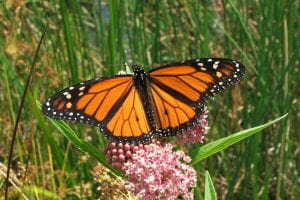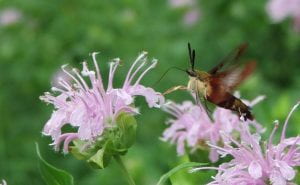By Pam Golben, Goshen Florida Gardener Volunteer
This article appeared in the March 2021 Issue of Gardening in Orange County.

Many native seeds require 60, 90 or 120 days of cold, moist conditions (stratification) to break dormancy and germinate. These seeds should be planted in the fall and will germinate when the conditions are right for them. If you didn’t plant native seeds last fall, do not be discouraged, there are a number of native species that only require 30 days of cold, moist stratification. If you plant these seeds by mid-March they will still germinate. In addition, there are native seeds that do not require any special conditioning at all to germinate.
Outdoor / Garden planting: Outdoor planting is the easiest, let Mother Nature do the work!
1) Whether you are planting seed in the ground in March or later, be sure to have an area that is prepared and weed free, weeds will out-compete your native seedlings. Planting seeds in pots or trays and leaving them in a protected area outside also works very well.
2) Plant native seeds only as deep as the width of the seed. Very tiny seeds should be sown on the soil surface with only a light dusting of soil over them. Most of the tiny seeds require exposure to sunlight to germinate.
3) Cover the ground or pots you planted with a piece of window screen or an old cotton sheet. Covering helps to keep the seeds moist, prevents them from being blown away by the wind and protects them from being eaten by birds. Remove the cover once you see the seeds have germinated.
4) Do not let seeds and seedlings dry out. You will need to water if the weather is dry.
5) Always label where your seeds are planted – it is amazing how fast you can forget.
Indoor Cold / Moist stratification:

1) Another way to provide 30 days of cold/moist stratification is to sprinkle the seeds on a damp paper towel or coffee filter, fold in half and seal them in a plastic bag. Place bag in the refrigerator for 30 days. If seeds germinate before the 30 days, remove them from the paper towel and carefully plant in pots.
2) You could also place the seeds in pots or trays of moist potting mix, seal them in a plastic bag and refrigerate. After 30 days, remove pots from their bag and place outside in a protected area.
Check out these links that have helpful directions on native seed germination. They also sell native seeds and provide plant descriptions. Have fun!
*Please note that different companies may use different codes to designate each type of stratification.
List of Native Plants that can be Planted in March
| Common Name | Scientific Name | Sunlight | Soil Moisture |
Bloom Time | Blossom Color | Germ. Code |
| Purple Coneflower | Echinacea pupurea | Full/Partial | Med Wet – Med Dry | July – Sept | Purple | A |
| Wild Bergamot | Monarda fistulosa | Full/Partial | Med Wet – Dry | July – Sept | Lavender | A |
| Spotted Bee Balm | Monarda punctata | Full/Partial | Medium – Med Dry | July – Sept | Purple, Pink | A |
| Com. Evening Primrose | Oenothera biennis | Full/Partial | Med Wet – Dry | June – Nov | Yellow | A |
| Mountain Mint | Pycnanthemum virginianum | Full/Partial | Wet – Med Dry | June – Sept | White | A |
| Blue Sage | Salvia azurea | Full/Partial | Medium – Dry | Aug- Oct | Blue | A |
| Smooth Blue Aster | Symphyotrichum laeve | Full/Partial | Med Wet – Med Dry | Aug – Oct | Blue | A |
| Aromatic Aster | Symphotrichum oblongifolium | Full | Med Dry – Dry | Aug- Nov | Purple | A |
| Shrubby St John’s Wort | Hypericum prolificum | Full/Partial | Med Wet – Med Dry | July – Sept | Yellow | A |
| Kalm St John’s Wort | Hypericum kalmianum | Full/Partial | Med Wet – Medium | July – Aug | Yellow | A |
| Purple Prairie Clover | Dalea pupurea | Full/Partial | Medium – Dry | July – Sept | Purple | A |
| Sneezeweed | Helenium autumnale | Full/Partial | Wet – Med Wet | Aug – Oct | Yellow | A |
| Anise Hyssop | Agastache foeniculum | Full/Partial | Med – Dry | June – Sept | Purple | C(30) |
| Pearly Everlasting | Anaphelis margaritacea | Full/Partial | Med Dry – Dry | June – Sept | White | C(30) |
| Prairie Sage | Artemisia ludoviciana | Full/Partial | Medium – Dry | June – Sept | Green | C(30) |
| Rose Milkweed | Asclepias incarnata | Full/Partial | Wet – Medium | July – Sept | Pink | C(30) |
| Prairie Milkweed | Asclepias sullivanti | Full | Med Wet – Medium | June – Aug | Pink | C(30) |
| Butterfly Milkweed | Asclepias tuberosa | Full/Partial | Medium – Dry | June – August | Orange | C(30) |
| Whorled Milkweed | Asclepias verticillata | Full/Partial | Medium – Dry | July – Sept | White | C(30) |
| Tall Bellflower | Campanula americana | Partial/Shade | Med Wet – Med Dry | July – Oct | Blue | C(30) |
| Harebell | Campanula ratundifolia | Full/Partial | Med Dry – Dry | June- Sept | Purple | C(30) |
| Partridge Pea | Chamaecrista fasciculata | Full/Partial | Medium – Dry | July – Sept | Yellow | C(30) |
| Lance-Leaf Coreopsis | Coreopsis lanceolata | Full | Med Dry – Dry | May – Aug | Yellow | C(30) |
| Bonset | Eupatorium perfoliatum | Full/Partial | Wet – Med Wet | July – Sept | White | C(30) |
| Joe Pye Weed | Eutrochium maculatum | Full/Partial | Wet – Med Wet | July – Sept | Pink | C(30) |
| Early Sunflower | Heliopsis helianthoides | Full/Partial | Med Wet – Med Dry | June – Sept | Yellow | C(30) |
| Fox Glove Beardtongue | Penstemon digitalis | Full/Partial | Medium-Med Dry | June-July | White | C(30) |
| Yellow Coneflower | Ratibida pinnata | Full/Partial | Medium – Med Dry | July – Sept | Yellow | C(30) |
| Black-Eyed Susan | Rudbeckia hirta | Full/Partial | Med Wet – Med Dry | June – Oct | Yellow | C(30) |
A = seeds need no stratification; C(30) = seeds need 30 days of cold, moist stratification
Information from Prairie Moon Nursery.
